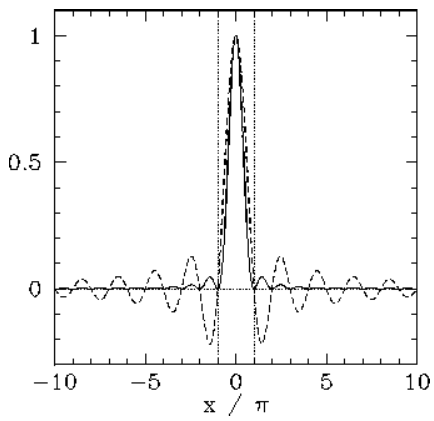12.5: Harmonic Perturbation
( \newcommand{\kernel}{\mathrm{null}\,}\)
Consider a (Hermitian) perturbation that oscillates sinusoidally in time. This is usually termed a harmonic perturbation. Such a perturbation takes the form
H1(t)=Vexp(iωt)+V†exp(−iωt), where V is, in general, a function of position, momentum, and spin operators.
It follows from Equations ([e13.48]) and ([e13.51]) that, to first-order, cf(t)=−iℏ∫t0[Vfiexp(iωt′)+V†fiexp(−iωt′)]exp(iωfit′)dt′, where
Vfi=⟨f|V|i⟩,V†fi=⟨f|V†|i⟩=⟨i|V|f⟩∗. Integration with respect to t′ yields cf(t)=−itℏ(Vfiexp[i(ω+ωfi)t/2]sinc[(ω+ωfi)t/2]=+V†fiexp[−i(ω−ωfi)t/2]sinc[(ω−ωfi)t/2]), where sincx≡sinxx.

Figure 25: The functions sinc(x) (dashed curve) and sinc2(x) (solid curve). The vertical dotted lines denote the region |x|≤π
Now, the function sinc(x) takes its largest values when |x|≲π, and is fairly negligible when |x|≫π. (See Figure [fsinc].) Thus, the first and second terms on the right-hand side of Equation ([e13.55]) are only non-negligible when
|ω+ωfi|≲2πt and |ω−ωfi|≲2πt respectively.
Clearly, as t increases, the ranges in ω over which these two terms are non-negligible gradually shrink in size. Eventually, when t≫2π/|ωfi|, these two ranges become strongly non-overlapping. Hence, in this limit, Pi→f=|cf|2 yields
Pi→f(t)=t2ℏ2{|Vfi|2sinc2[(ω+ωfi)t/2]+|V†fi|2sinc2[(ω−ωfi)t/2]}.
Now, the function sinc2(x) is very strongly peaked at x=0, and is completely negligible for |x|≫π. (See Figure [fsinc].) It follows that the previous expression exhibits a resonant response to the applied perturbation at the frequencies ω=±ωfi. Moreover, the widths of these resonances decease linearly as time increases. At each of the resonances (i.e., at ω=±ωfi), the transition probability Pi→f(t) varies as t2 [because sinh(0)=1]. This behavior is entirely consistent with our earlier result ([e13.28]), for the two-state system, in the limit γt≪1 (recall that our perturbative solution is only valid as long as Pi→f≪1).
The resonance at ω=−ωfi corresponds to Ef−Ei=−ℏω. This implies that the system loses energy ℏω to the perturbing field, while making a transition to a final state whose energy is less than the initial state by ℏω. This process is known as stimulated emission. The resonance at ω=ωfi corresponds to Ef−Ei=ℏω. This implies that the system gains energy ℏω from the perturbing field, while making a transition to a final state whose energy is greater than that of the initial state by ℏω. This process is known as absorption.
Stimulated emission and absorption are mutually exclusive processes, because the first requires ωfi<0, whereas the second requires ωfi>0. Hence, we can write the transition probabilities for both processes separately. Thus, from Equation ([e13.49]), the transition probability for stimulated emission is Pstmi→f(t)=t2ℏ2|V†if|2sinc2[(ω−ωif)t/2], where we have made use of the facts that ωif=−ωfi>0, and |Vfi|2=|V†if|2. Likewise, the transition probability for absorption is
Pabsi→f(t)=t2ℏ2|V†fi|2sinc2[(ω−ωfi)t/2].
Contributors and Attributions
Richard Fitzpatrick (Professor of Physics, The University of Texas at Austin)


